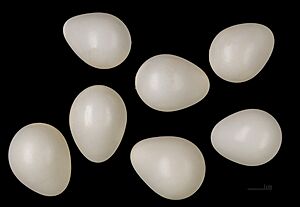Grey-headed woodpecker facts for kids
Quick facts for kids Grey-headed woodpecker |
|
|---|---|
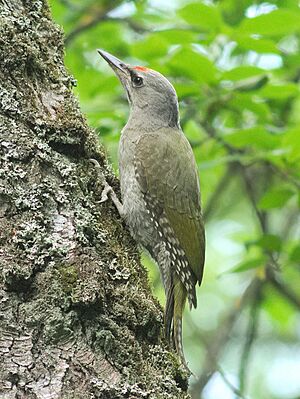 |
|
| Conservation status | |
| Scientific classification | |
| Genus: |
Picus
|
| Species: |
canus
|
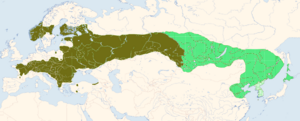 |
|
| Distribution of the subspecies
Picus canus canus Picus canus jessoensis Picus canus griseoviridis (see Korea) |
|
The grey-headed woodpecker (Picus canus) is also called the grey-faced woodpecker. It is a type of woodpecker found across Eurasia. This bird is related to the European green woodpecker and the Iberian green woodpecker. You can find it from central Europe all the way to the Pacific Ocean.
Grey-headed woodpeckers like specific homes. They prefer forests with trees that lose their leaves, especially if there are many dead trees. They mostly eat ants, but they also eat other things. These woodpeckers usually make their nests inside dead or damaged trees.
Sadly, in many places, the number of grey-headed woodpeckers is going down. However, because they live in such a large area, they are currently listed as Least Concern by the IUCN. This means they are not in immediate danger of disappearing.
Contents
About the Grey-headed Woodpecker
Naming the Woodpecker
The German scientist Johann Friedrich Gmelin officially described the grey-headed woodpecker in 1788. He gave it the scientific name Picus canus. The word canus comes from Latin and means "grey". Gmelin learned about this bird from an English naturalist named George Edwards. Edwards had described a "grey-headed green woodpecker" from Norway in 1747.
There are ten different types, or subspecies, of the grey-headed woodpecker. These are slightly different versions of the same bird, often found in different places.
- P. c. canus Gmelin, JF, 1788 – Found in north and central Europe to west Siberia.
- P. c. jessoensis Stejneger, 1886 – Lives from east Siberia to northeast China, Korea, and north Japan.
- P. c. kogo (Bianchi, 1906) – Found in central China.
- P. c. guerini (Malherbe, 1849) – Lives in north central and east central China.
- P. c. sobrinus Peters, JL, 1948 – Found in southeast China and northeast Vietnam.
- P. c. tancolo (Gould, 1863) – Lives on Hainan Island (off southeast China) and Taiwan.
- P. c. sordidior (Rippon, 1906) – Found from southeast Tibet and southwest China to northeast Myanmar.
- P. c. sanguiniceps Baker, ECS, 1926 – Lives from northeast Pakistan to north India and west Nepal.
- P. c. hessei Gyldenstolpe, 1916 – Found from Nepal and northeast India to Myanmar and Indochina.
- P. c. robinsoni (Ogilvie-Grant, 1906) – Lives in west Malaysia.
Sometimes, grey-headed woodpeckers and European green woodpeckers have babies together. These mixed babies are very rare. Their feathers often look more like a grey-headed woodpecker. But they might have some red on their head or neck.
What the Woodpecker Looks Like
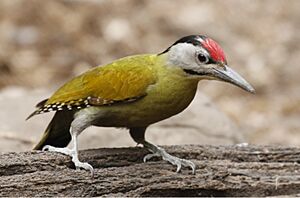
The grey-headed woodpecker is about 25 to 26 centimeters (10 inches) long. Its wings spread out about 38 to 40 centimeters (15 inches). It weighs around 125 grams (4.4 ounces).
Male grey-headed woodpeckers have a grey head with a red patch on the front. They have a black line near their eyes and a thin black "mustache" stripe. Their back and wings are green. Their chest and belly are light grey.
Female grey-headed woodpeckers do not have the red patch on their head. Instead, they have thin black lines on their crown.
Different subspecies can look a bit different. For example, the Picus canus jessoensis is a bit greyer than the main type. The Chinese Picus canus guerini has a black patch on its neck and a greenish belly. The Picus canus hessei is similar but has more golden-green on top and deeper green underneath.
Overall, grey-headed woodpeckers have olive green on their upper body. This color changes to light grey on their neck and head. They have a grey head with a black mustache. The male has a red crown. They have a shorter neck and a thinner beak than the green woodpecker. They are about the size of a Eurasian collared dove.
Sounds of the Woodpecker
The calls of the grey-headed woodpecker are similar to the European green woodpecker. But the grey-headed woodpecker's song is more musical. It sounds like a series of ten to fifteen notes that get lower in pitch and slower. This song can sound a bit sad. Female songs are similar but quieter and sometimes shorter.
Both male and female woodpeckers make sharp kuek sounds. These calls can be a warning if a predator is nearby. If parents make this call, their young in the nest will immediately become quiet.
Grey-headed woodpeckers also drum on trees. They drum more often than European green woodpeckers. Their drumming can be very fast, up to 20 beats per second. A "drum roll" can last up to two seconds. Both males and females drum, but females usually drum less often and more quietly. These woodpeckers often use the same drumming spots for many years. They even drum on metal covers on masts and roofs because these make a good sound.
Where the Woodpecker Lives
The grey-headed woodpecker lives in many parts of Central, Northern, and Eastern Europe. It also lives across Asia, reaching the Pacific coast, Sakhalin, and Hokkaidō. They live in areas where coniferous (evergreen) and mixed forests meet. They do not live where forests turn into treeless grasslands. In East Asia, they are found in places like the Korean Peninsula, China, and the mountain forests of the Malay Peninsula.
In Europe, this woodpecker lives from western France to the Urals mountains. It is found in Scandinavia and Central, Eastern, and Southern Europe. You won't find them in the British Isles, Iberian Peninsula, or Mediterranean islands. In Italy, they only live in the very northern parts.
Woodpecker Life and Habits
Reproduction and Life Cycle
Grey-headed woodpeckers usually breed in May. They lay five to ten eggs. Both parents take care of the eggs. The eggs hatch after 15 to 17 days. The young birds are ready to leave the nest after 24 to 25 days.
What the Woodpecker Eats
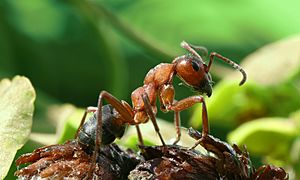
The grey-headed woodpecker is good at hunting ants, but not as much as the European green woodpecker. This means they can live in the same areas as green woodpeckers. They can even nest close to them, sometimes only 100 meters apart.
Ants and their young make up most of the grey-headed woodpecker's diet, especially in spring and summer. They mostly eat wood ants (like Formica rufa), and other types of ants (like Lasius and Myrmica). Sometimes, ants and termites can be 90% of what they eat!
Besides ants, they also eat other insects. This includes caterpillars, crickets, larvae of bark and wood beetles, flies, spiders, and lice. In late autumn and early winter, they start eating more plant-based foods. This includes berries and other fruits.
Conservation Status
It can be hard to count grey-headed woodpeckers because they don't always call out. This means some pairs might be missed. It seems that in Europe, especially in the northwest, their numbers have gone down. But since the 1990s, their populations seem to be getting better because of milder winters.
Globally, there's a small drop in their numbers, but it's not enough to make them a threatened species. So, the species is considered safe.
The total number of grey-headed woodpeckers in Europe is thought to be between 180,000 and 320,000 breeding pairs. Many of these birds live in the European parts of Russia and Romania. Germany has about 15,000 pairs, Austria has about 2,500, and Switzerland has about 1,500. We don't have exact numbers for populations outside Europe.
Grey-headed woodpeckers prefer old, undisturbed forests with many different types of trees. They also like forests near rivers. So, losing these types of homes is the biggest danger to them.



